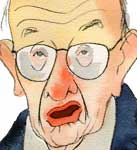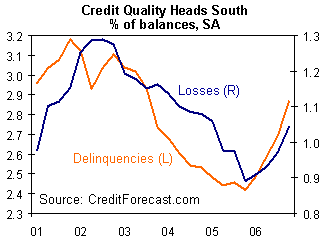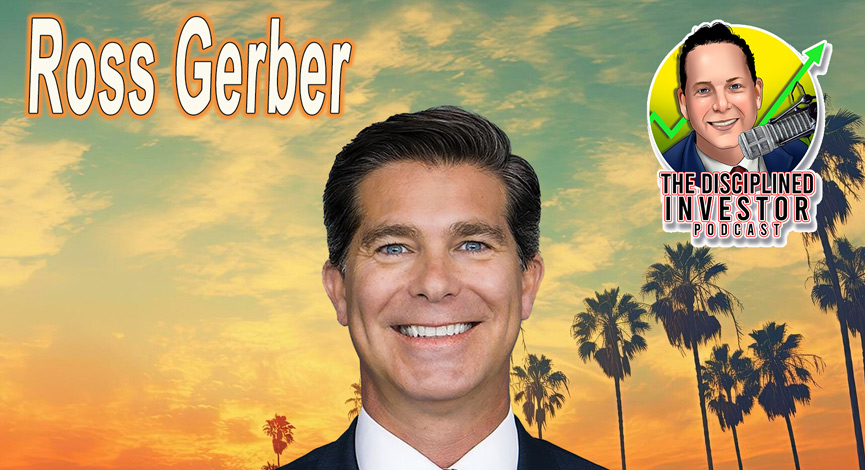It now has become a bit surreal to watch these markets have such a profound reaction to events that are, well, petty. While the Hang Seng and the European markets have suddenly and viciously slumped, investors in the US markets have succumbed to the old Henny Penny attitude that the sky is falling. Even though there has not been a significant change in the underlying economics, there has been a change in investor sentiment. Where is the love?
 Mr. Bigshot just cannot leave well enough alone. Every time the party seems to get going, he is the one that goes and pulls the fire alarm. What a party-pooper! Again, the question that begs to be asked is WHY NOW? The answer may be a bit disconcerting…
Mr. Bigshot just cannot leave well enough alone. Every time the party seems to get going, he is the one that goes and pulls the fire alarm. What a party-pooper! Again, the question that begs to be asked is WHY NOW? The answer may be a bit disconcerting…
Remember back to his irrational exuberance speech given in the late 90‘s. The effects of his comments were felt near and far and it took a few years for the markets to adjust to the overbought measure that he addressed. Today is quite a different story and rest assured that the markets are resilient. Even with these negative comments, the fact is that fundamentals have not changed worldwide. Does anyone wonder if the fact the Greenspan has his biography slated to be released in the spring of 2007 have anything to do with his timing of these statements. He is usual manner is rather cryptic when discussing economics, yet his 1 0ut 0f 3 chances of a rescession comment was very clearly explained.
Excuse me for be a skeptic, but there is too much of a coincidence in the timing of these comments and the need for a good shot of publicity for the book.Again, the economics have not changed. In fact, Bloomberg ran a story late Monday night discussing the surge in Asian shares on Tuesday. Quoting Michael Birch of Wallace Funds Management in Sydney: “Nothing has actually changed for shares fundamentally, and you’re going to get more investors buying stocks once they’re confident that the slump was a temporary event”.
Let‘s roll up the sleeves and get to the facts; the reality is that the housing market has and will continue to be a concern as we see the slowing down of sales and the end of property value increases. But remember that this is a cyclical event that will continue to cause problems for those areas around the country that have economies that are tied to consumer related goods (Look at Michigan as an area that has seen a big economic downturn as the auto industry is in a slump and the area‘s housing prices have severely eroded)
Yet at the same time, personal income (exclusive of the home value effect) has been surprisingly strong and increasing. According to a recent report by Economy.com; Real disposable income rose a sturdy 0.5% and is running 4.4% above the fourth quarter average. Continued strong growth is required to maintain recent strength in consumer spending, and final demand is to be maintained in an environment of negative saving…
At the same time, we are seeing reports of concern over the aggressive behavior of banks and other lending institutions in providing loans to sub-prime borrowers.
It has been obvious for some time that there has been odd behavior with the lending community. One of the more recent ideas that shows how loose money has become is the promotion of lending money for 2nd mortgages simultaneously when issuing the 1st on a new mortgage. The market finally realized that these tactics along with others have created pronounced problems with sub-prime lenders. New Century Financial Corp. was all but left for dead on Monday as investors sold it down over 65% for the session. Fremont General Corp. slumped $2.82, or 32 percent, to $5.89 and Countrywide Financial Corp also moved lower as did many of the larger lenders.
Surely the last 5 years can be looked at as a consumer lead expansions and that fact does have some cause for alarm for sectors such as Consumer Discretionary, Consumer Staples and some Technology. The flip side is that it may finally be time to take a good look at the Health Care and even Industrials. Even as the sub-prime market shakes out, the money to be made by banking institutions on spreads is very profitable. With that in mind, these institutions will continue to lend as much as they can within the parameters of the law.

Here is where it is a concern. Back in the days just before the great market crash of 1929 and the continued decline through 1932, there was one clear explanation of what had happened. Investors were given margin without limit that was even close to reasonable. The brokerage houses were lending money to anyone with an account as stocks were considered the shortest and easiest path towards riches. Since there were no real limits imposed by regulators, brokerages provided the leverage as they saw it as a profitable enterprise and investors gobbled it up buying more stock than they should have, ignoring the potential pitfalls.
History is repeating itself today. Substitute today‘s real estate for the stock market and mortgages for margin. There no particular limits that a person can have if they choose to buy investment properties with a small amount of money down (10%) and a simple plan to fix it up and sell it off for a “quick” profit. Of course everyone is now an overnight expert in real estate investment too. What is happening is the equivalent of margin calls that caused investors of the 20‘s to loose on a grand scale.
Housing properties are coming down as interest rates have climbed. Inventory of new homes is high and resale(s) are slow. Too many real estate investors are now stuck having to pay the monthly mortgage payments on properties they never had any intention on holding on to. The situation is compounded by the fact that as they are being forced to sell the properly to get some relief, more inventory is created with must sell pricing.
This will eventually cause a liquidity crisis and we will continue to see bankruptcies on the rise along with record numbers of new construction contract being abandoned. Builders will invariably keep building (that is all they know how to do) which once again keeps inventories high. Prices will continue to suffer and eventually we may see the price points break as sellers will create price wars.
Case in point: A February 27th report by Marketwatch showed that two builders were showing sharp losses related to their Florida business segment. Hovnanian (HOV) said it expects to book about $90 million in charges related to operations in Fort-Myers-Cape Coral, Fla., “due to a continued decline in sales pace and general market conditions, as well as increasing cancellation rates, during the quarter.” In that same report, WCI Communities (WCI) Meanwhile, in the traditional home-building operations, revenue fell from a year earlier as 22% of buyers scheduled to close defaulted in the fourth quarter. Unit deliveries fell to 434 from 859 in the year-ago quarter.
All of this is weighing heavily on the markets and until we see a change in the lending practices or a much need overhaul of the lending rules there will be great repercussions to the housing and lending industry. This will (and is) have a negative impact on the rest of the investment markets as confidence will erode and money will be held hostage to the cycle.
WAKE UP REGULATORS! HOW CAN WE LET THIS HAPPEN?
For sure, stay clear of the real estate market, including REITS. Subprime lenders are not a buy, no matter how cheap they seem to be. Savings and Loans are also a No-No. If only we could have seen this coming Well actually we did and no one seemed to pay any attention. Sorry to say, there is more pain that these sectors will need to endure and it is very unclear how they will come back from the ashes after the smoke (and fire) is cleared. For now, watch and wait. This will be interesting an interesting story for the history books.
Greenspan Art – Paul Giambarba
















